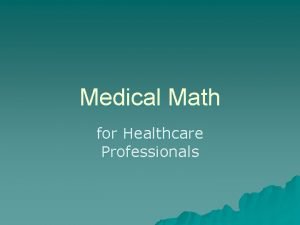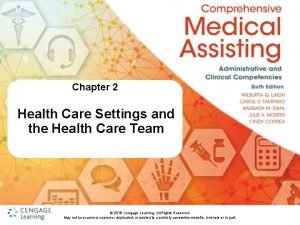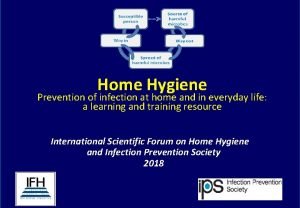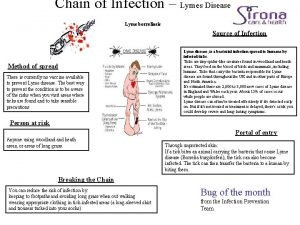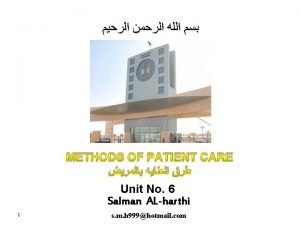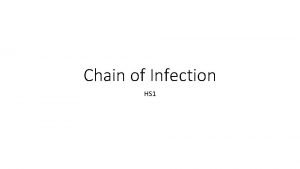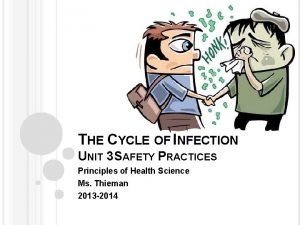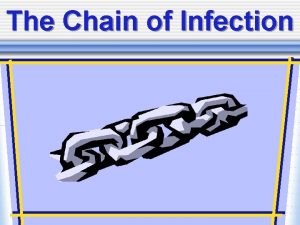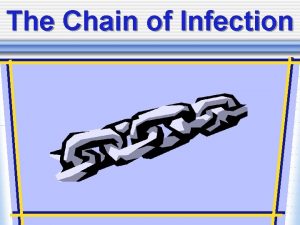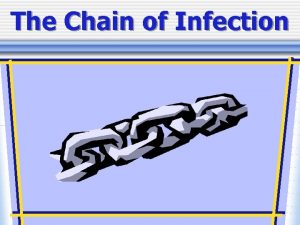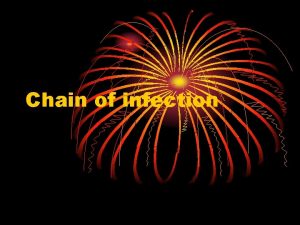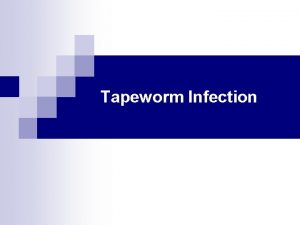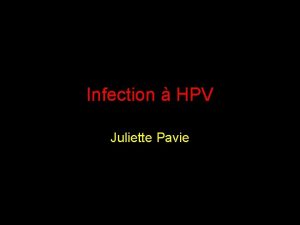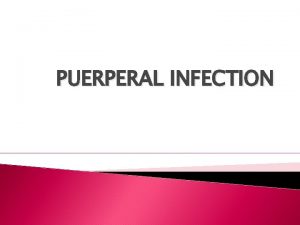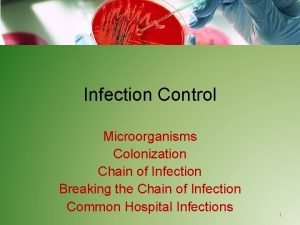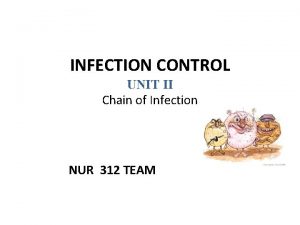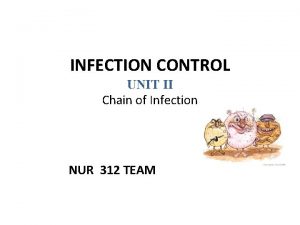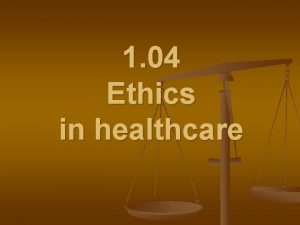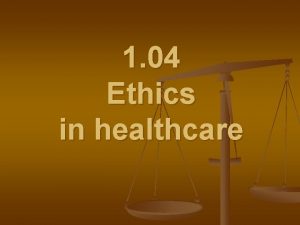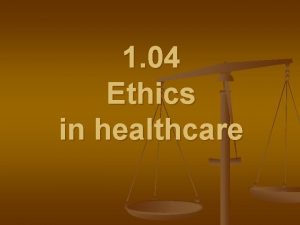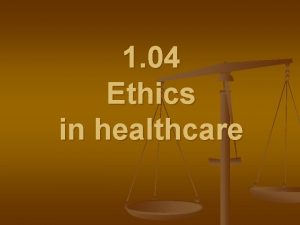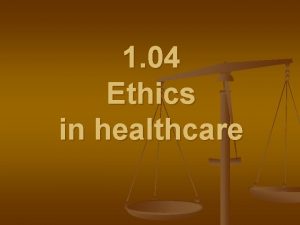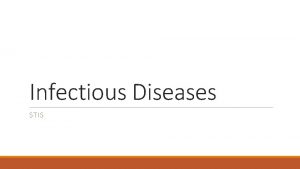The Chain of Infection As healthcare professionals it































- Slides: 31

The Chain of Infection

As healthcare professionals, it is important to understand two facts about infection: 1. The various ways infection can be transmitted. 2. The ways the infection chain can be broken.

There are six links in the chain of infection: 1. Causative agent 2. Source or reservoir 3. Portal of exit 4. Mode of transmission 5. Portal of entry 6. Susceptible host

1 st - The Infectious Agent -Any disease-causing microorganism (pathogen)

Microorganism A small, living plant or animal not visible to the naked eye

Pathogens vs. Nonpathogens are beneficial microorganisms that are found on and in the human body Pathogens cause disease/infection

Class I - Bacteria • Multiply rapidly • Classified by shape and arrangement

Cocci • Round or spherical in shape • If Cocci occur in pairs they are diplococci • If Cocci occur in chains they are streptococci • If Cocci occur in clusters or groups they are staphylococci

Cocci are the most common pusproducing microorganisms Diplococci bacteria cause diseases such as Gonorrhea, Meningitis, & Pneumonia. Streptococci bacteria cause diseases such as Strep throat and Rheumatic fever.

Staphylococci Can cause infections such as w. Boils w. Wound infections w. Toxic shock

Bacilli • Rod shaped • Occur singly, in pairs, or in chains

Bacilli Many bacilli contain flagella, threadlike projections that are similar to tails and allow organisms to move Bacilli have the ability to form spores, thick walled capsules. In the spore form, bacilli are extremely difficult to kill.

Diseases caused by different types of bacilli include: • Tuberculosis • Tetanus • Pertussis • Whooping cough • Botulism • Diphtheria • Typhoid

Class II - Protozoa one-celled animals often found in decayed materials and contaminated water.

Class III - Fungi simple, plantlike organisms that live on dead organic matter.

Two common fungi forms: • Yeasts • Molds

Fungi cause diseases such as: • Ringworm • Athlete’s foot • Histoplasmosis • Thrush

Class IV - Rickettsiae (ri-ket-se-a) parasitic microorganisms which means they cannot live outside the cells of another living organism. Commonly found in fleas, lice, ticks, mites

Rickettsiae transmitted to humans by the bites of these insects (typhus fever, rocky mountain spotted fever).

Class V - Viruses • Difficult to kill because they are resistant to many disinfectants and antibiotics. • Smallest microorganism • Cause diseases such as w Common cold w Measles, Mumps w Influenza w Chicken pox w Warts

2 nd - The Reservoir Host -The organism in which the infectious microbes reside

What are “Carrier Hosts? ” Hosts that do not show any outward signs or symptoms of a disease, but are still capable of transmitting the disease are known as carriers.

3 rd - The Portal of Exit -Route of escape of the pathogen from the reservoir Examples: respiratory secretions, blood exposure, breaks in skin

4 th - The Route of Transmission Method by which the pathogen gets from the reservoir to the new host • direct contact • air • insects

5 th - The Portal of Entry • Route through which the pathogen enters its new host w Respiratory System (inhalation) w Gastrointestinal System (ingestion) w Urinary & Reproductive Tracts (sexual contact) w Breaks in Skin (Protective Barrier)

6 th - The Susceptible Host • The organism that accepts the pathogen • The support of pathogen life and its reproduction depend on the degree of the host’s resistance. • Organisms with strong immune systems are better able to fend off pathogens. • Organisms with weakened immune systems are more vulnerable to the support and reproduction of pathogens.

How to interrupt the chain of infection: 1. Pathogen Identification: identify infectious agent and appropriate treatment 2. Asepsis and Hygiene: potential hosts and carriers must practice asepsis and maintain proper personal hygiene 3. Control Portals of Exit: Healthcare personnel must practice standard precautions (Control body secretions and wash hands according to protocol. )

4. Prevent a Route of Transmission Prevent direct or indirect contact by 1. Proper hand washing 2. Disinfection & sterilization techniques 3. Isolation of infected patients 4. Not working when contagious

5. Protect Portal of Entry Healthcare professionals must make sure that ports of entry are not subjected to pathogens. (nose, mouth, eyes, open wounds, etc. )

6. Recognition of Susceptible Host Healthcare professionals must recognize and protect high-risk patients. Cancer Patients • AIDS Patients • Transplant Patients • Infants • Elderly Patients

“Remember--breaking the chain of infection is the responsibility of each healthcare professional. ”
 Chapter 13 medical math
Chapter 13 medical math Healthcare and the healthcare team chapter 2
Healthcare and the healthcare team chapter 2 Sports medicine definition
Sports medicine definition Eltonian pyramid
Eltonian pyramid Breaking the chain of infection
Breaking the chain of infection Chain of infection
Chain of infection Chain of infection for lyme disease
Chain of infection for lyme disease Infection process cycle
Infection process cycle Portal of entry
Portal of entry Spiderbite ngt
Spiderbite ngt Difference between logistics and supply chain
Difference between logistics and supply chain Open kinematic chain
Open kinematic chain Tư thế ngồi viết
Tư thế ngồi viết Diễn thế sinh thái là
Diễn thế sinh thái là Thứ tự các dấu thăng giáng ở hóa biểu
Thứ tự các dấu thăng giáng ở hóa biểu Ng-html
Ng-html Phép trừ bù
Phép trừ bù Hát lên người ơi
Hát lên người ơi Hổ sinh sản vào mùa nào
Hổ sinh sản vào mùa nào đại từ thay thế
đại từ thay thế Quá trình desamine hóa có thể tạo ra
Quá trình desamine hóa có thể tạo ra Vẽ hình chiếu vuông góc của vật thể sau
Vẽ hình chiếu vuông góc của vật thể sau Công thức tiính động năng
Công thức tiính động năng Tỉ lệ cơ thể trẻ em
Tỉ lệ cơ thể trẻ em Thế nào là mạng điện lắp đặt kiểu nổi
Thế nào là mạng điện lắp đặt kiểu nổi Các loại đột biến cấu trúc nhiễm sắc thể
Các loại đột biến cấu trúc nhiễm sắc thể Lời thề hippocrates
Lời thề hippocrates Bổ thể
Bổ thể Vẽ hình chiếu đứng bằng cạnh của vật thể
Vẽ hình chiếu đứng bằng cạnh của vật thể độ dài liên kết
độ dài liên kết Môn thể thao bắt đầu bằng từ đua
Môn thể thao bắt đầu bằng từ đua Sự nuôi và dạy con của hươu
Sự nuôi và dạy con của hươu
